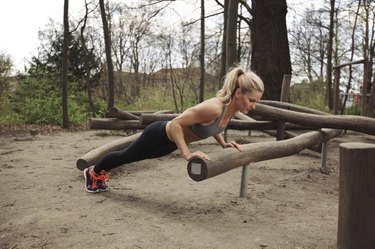
Change up your push-up routine to vary the muscles you challenge. When you switch up the plain old push-up and perform it off of an incline you put more emphasis on the lower part of the chest.
How intense the move is depends on the height of the incline. Use a high incline, such as a countertop, and you get less intensity; a lower incline, such as a porch step, increases the difficulty of the move.
Video of the Day
Video of the Day
How to Do an Incline Push-Up
An incline push-up involves the same important form cues, such as keeping the torso straight and the hands shoulder-distance apart, as a standard push-up.
Step 1
Place your hands flat on an incline surface about shoulder-distance apart. Walk your feet back until your body forms a straight line from your heels to your shoulders. Brace your abdominals.
Step 2
Bend your elbows to form a 45-degree angle with your trunk. Lower just until your elbows are parallel to your back.
Step 3
Extend your elbows to return to the start position to complete one repetition.

Muscles Worked
When you're performing your incline push-up, a number of muscles fire.
Primary and Synergestic Movers
These are the muscles directly affected and trained with the incline push-up. The deltoid and triceps get a workout, but are emphasized to a lesser degree compared to the pectoralis major.
Pectoralis Major: The pectoralis major muscle is the primary chest muscle. The incline specifically targets the mid-lower, or sternal, portion of this fan-shaped muscle. The clavicular, or upper portion of the muscle, is also activated to a lesser degree.
Anterior Deltoid: The cap of the shoulder is covered with a rounded, triangular muscle called the deltoid. It has three points of origin, and thus three distinct bands of muscle fibers. The anterior deltoid forms at the front of the shoulder and clavicle.
Triceps Brachii: The triceps are located at the back of the upper arm and are responsible for extension of the elbow. When defined, they appear as a horseshoe shape.
Read More: Push-Ups that Work the Shoulders
Stabilizing Muscles
Stabilizers keep your body in proper position and fire to keep you stable during the incline push-up.
Abdominals: Part of performing a push-up correctly is holding your body rigid in a strong plank position as you bend and extend your elbows. Your abdominal muscles, including the rectus abdominus and obliques, are responsible for this stabilization. The muscles along the spine known as the erector spinae are also important in keeping your core strong.
Biceps: The shortest of the two biceps muscles dynamically stabilizes your elbow joint as you bend and extend into the push-up.
Pectoralis Minor: The pectoralis minor is a small, thin muscle in the upper chest that sits behind the pectoralis major.
Serratus Anterior: The serratus anterior sits on top of the upper ribs and extends to the back of lower shoulder, or scapula, at the backside of your body.
Quadriceps: Your quadriceps are four muscles located at the front of your thighs. These muscles keep your legs strong and stable as you hold your body straight.
Lower Legs: Both the calf muscles, the gastrocnemius and soleus, also stabilize your lower body and legs as you do the push-up. The gastrocnemius is the primary muscle that you feel at the back of your calf; the soleus is a smaller muscle that sits behind it.
Who Should Do an Incline Push-up?
Anyone can benefit from the incline push-up, but it's especially helpful to those just starting out with push-ups or those who haven't yet developed the strength to do a full push-up. The angle provides some support for your body weight, making the move more doable for most people.
Read More: Regular vs. Elevated Push-Ups